This is my 500th blog post! If you’ve followed along with me from the beginning, thank you! And if you are a recent reader, I’m so glad that you are here!
With 500 posts under my belt, you’ve gotten to know me pretty well, and by now you all now how much I love to read. What you might not know is that I enjoy tracking my reading progress almost as much as I enjoy reading itself. With my INFJ personality and my predilection for rigorous documentation of all aspects of my life, an overzealous enthusiasm for book tracking was inevitable!
I suppose that some spontaneous, fly-by-the-seat-of-your-pants readers (I’m told they exist) might find my meticulous record keeping tedious, but for me it actually enhances the reading experience. And apparently I’m not alone: in January, Anne Bogel dedicated an entire episode of her podcast to how her listeners track their books. I was intrigued and inspired by the unique tracking methods described, and since it was so much fun for me to see how other readers track their reading, I thought you might be interested in seeing how I track mine.
Since I am literally incapable of doing anything the simple way, I actually have five separate methods for tracking my reading. Is it overkill? Probably. But each of these methods satisfies a different one of my hyperdocumention needs (<— it’s a disease!), so for now I’ll be keeping up with my system.
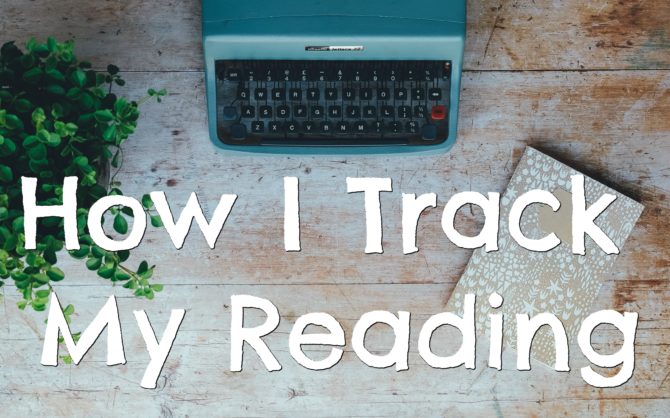
1. Goodreads
Like many modern readers, Goodreads is my primary internet home for book tracking. My TBR list lives here; the only drawback is that there isn’t a way to record where I learned about a book—the one gaping hole in my reading records. (I usually will remember where I first learned about a book, and I’ll make a note of it when I write a review of the book once I’ve finished it, but sometimes this information falls through the cracks.)
I don’t usually post my own full reviews on Goodreads, but I love reading others’ reviews and use these to determine whether or not the book should be added to my TBR in the first place. It’s fun for me to see what books my friends have read and what they thought of a particular title; it’s surprising how often their opinions don’t line up with my own.
Once I finish a book, I give it a star rating (unfortunately, Goodreads doesn’t allow half stars so I round up or down), and add it to my Read shelf. I’ve also created a few additional shelves, including one for my All Time Favorites and separate shelves for my Reading Challenge books. Goodreads offers many additional features that I don’t use, but I (mostly) love this platform and can’t imagine how I navigated my reading life in a predigital age!
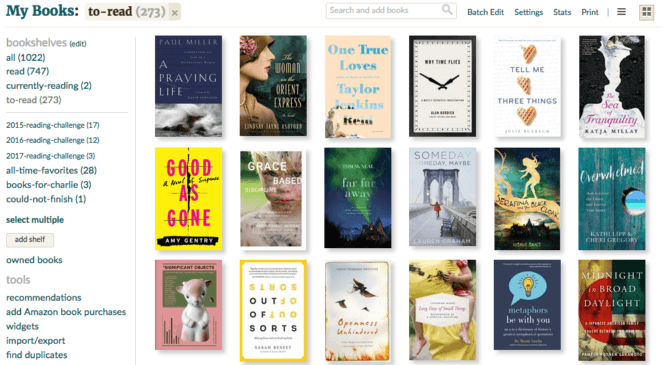
2. Pinterest
Pinterest isn’t as popular as it once was, and I find myself visiting the site a lot less frequently these days, but I still use it as one of my book tracking sources. Each January I start a new Pinterest board for books I read that year. I’ve been doing this since 2012, so I now have quite a collection!
I’ve done things differently in the past: prior to starting a blog, I wrote full book reviews in my pins, and for a while I pinned my blog’s reading roundups rather than individual books. My current system looks like this: when I finish a book, I pin the book from Amazon. This gives me a nice, uniform look among my pins. In my pin description, I write a one-sentence review and include my star rating.
If I had to let a tracking method go, it would probably be this one simply because it isn’t filling a need not already covered by my other methods. But I do like having a nice visual of the books I’ve been reading, and since I’ve been using this method for so long, it’s hard to give it up.
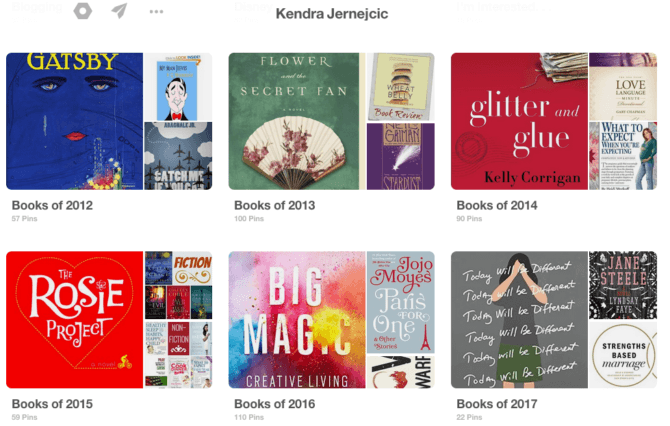
3. Analog List
As great as technology is, I like to keep paper records of some things, including my books, so I have a few pages dedicated to book tracking in the paper calendar/agenda I use as a pseudo bullet journal. I keep a numbered list of my book titles, the dates of when I started and finished each book, and a star rating of the book. Next to each title I write an A if it was an audiobook, and RC if I counted it towards my Reading Challenge.
I also use this journal to keep a tally chart of my book ratings, fiction and nonfiction books, and book format (audiobook, Kindle, or paper). As you can see in the picture below, I’ve been doing a lot of audiobooks lately!
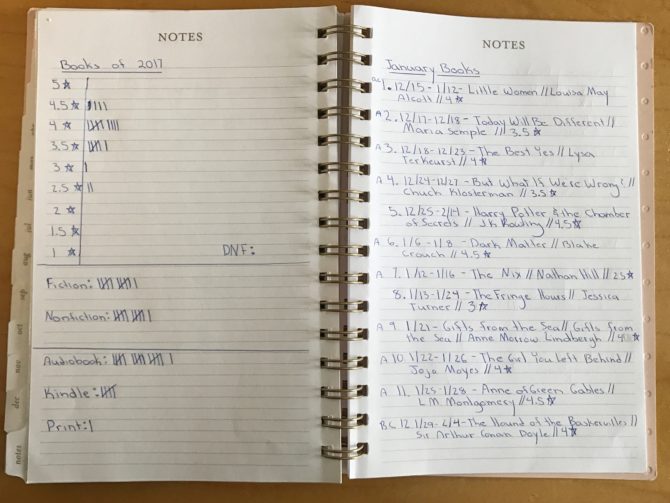
4. Day One
I’ve sung the praises of Day One before. I write my daily journal entries in this app, and I also write separate journal entries for every book I read. The app allows you to tag entries, so all of these book entries are given a book tag as well as tags for their rating, fiction/nonfiction, and audiobook where applicable. With each entry I write a detailed book review that I reference when compiling reviews I share here on the blog. I also include quotes that stood out to me and other information I might want to remember, such as who recommended the book. Since the app allows you to include a picture with each entry, I always include a snapshot of the cover (if it’s a print book) or, if it’s an ebook or audiobook, a picture of the cover that I’ve found online.

5. On the Blog!
This one you already know about! My Quick Lit reading wrap-ups include reviews of the books I read in the previous month. I don’t include every book I’ve read, but I do write about most of them. I enjoy sharing these reviews and you seem to as well—these are usually my most popular posts of the month. The blog has also become my space for documenting my favorite books of the year, which I share every December.
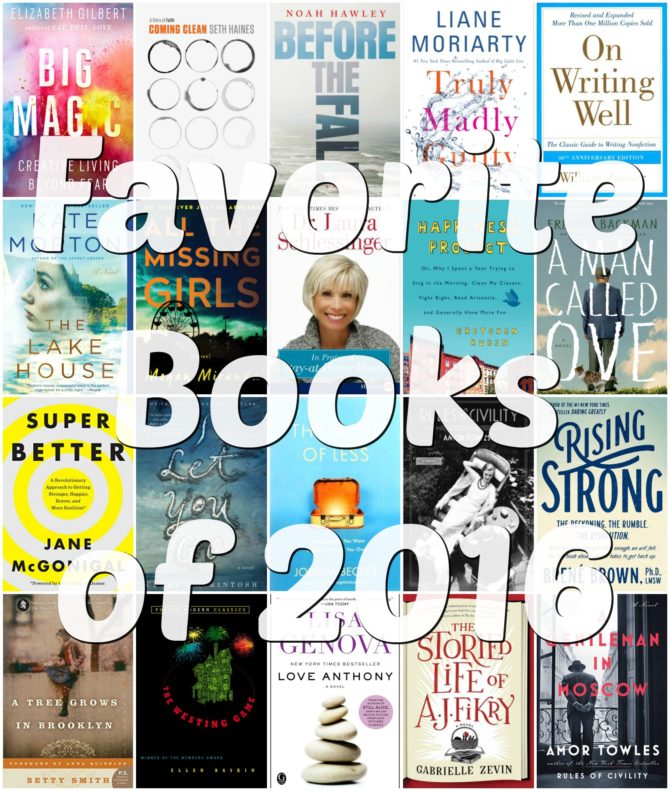
Do you have a unique way to track your reading? I’d love to know about it!
[…] :: How I Track My Reading :: Every reader loves hearing about how others track their books; these are my methods. […]
[…] analyzing what I’ve read makes the reading experience so much sweeter! I use various methods to track my reading throughout the year; that part alone is fun for me, but my biggest reward comes in December when I […]